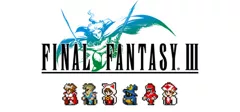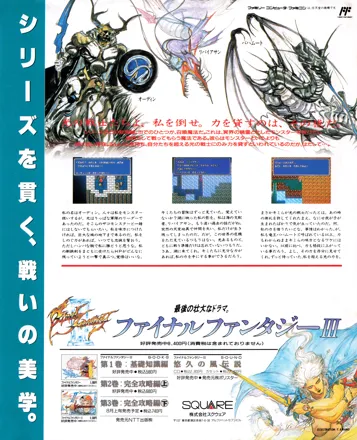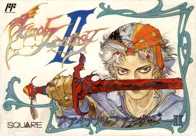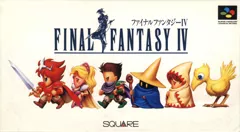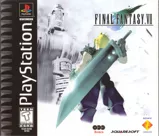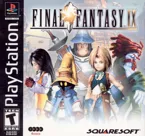Final Fantasy III
-
 Final Fantasy III
(1994 on
SNES, 1999 on
PlayStation, 2006 on
Game Boy Advance...)
Final Fantasy III
(1994 on
SNES, 1999 on
PlayStation, 2006 on
Game Boy Advance...)
Description
In a remote village of Ur, four orphan boys were raised by the priest Topapa. Once, the Crystal of Wind, guarded by the people of Ur, sank deep into the earth. The four boys decided to retrieve it from there and went down into an underground cave. But when they found the crystal, it spoke to them and from its words they understood they were chosen for a much more important and world-embracing mission...
Final Fantasy III is the third Final Fantasy game for the NES platform. It was the last Final Fantasy game that does not use the ATB (active time battle) system (until it was removed again in Final Fantasy X). The turn-based battle engine has been improved: if the enemy is defeated, the next character will automatically switch to another enemy, and not hit the air, like in the previous two games.
Before the game begins, you give names to the four boys, which look the same (only in different colors) and belong all to the same class - the scrawny Onion Kid. Very quickly, however, you're able to give your heroes "jobs" - proper character classes, such as Fighter, Black Mage, Viking, Shaman and others. Each job has different capabilities and can use different equipment. More powerful jobs become available later in the game. The characters can change jobs throughout the game, though it costs them "Capacity Points" (which are earned in battle).
The game itself is, like the previous games, a top-down RPG where your characters travel in the overworld, sometimes entering cities and dungeons to buy equipment, rest and fight random encounters and bosses with turn-based combat.
Some minor issues were slightly changed to resemble more the classical Final Fantasy look (such as the menu layout etc.).
Spellings
- ファイナルファンタジーIII - Japanese spelling
- 最终幻想3 - Chinese spelling (simplified)
Groups +
Screenshots
Promos
Videos
Add Trailer or Gameplay Video +1 point
See any errors or missing info for this game?
You can submit a correction, contribute trivia, add to a game group, add a related site or alternate title.
Credits (NES version)
41 People (18 developers, 23 thanks) · View all
| Program | |
| Character | |
| Scenario | |
| Music | |
| Design | |
| Battle Program | |
| CG Design | |
| Obj Design | |
| Music Program | |
| Sound Effect | |
| Special Thanks To | |
| [ full credits ] | |
Reviews
Critics
Average score: 86% (based on 6 ratings)
Players
Average score: 3.7 out of 5 (based on 41 ratings with 2 reviews)
The ultimate 8-bit roleplaying experience.
The Good
Final Fantasy III represents a milestone in the FF series. It created the much-vaunted Job System seen in FFV, FF Tactics and FF Tactics Advance (and upcoming in FFX-2). It introduces the beloved high-flying Dragoon (a fan-favorite that returns in the persons of Kain and Freya), the mysterious Summoner (who later becomes so important as to be a main focus of both FFIX and FFX!), the item-plundering Thief (improved from its misnamed FFI predecessor) and the ominous Dark Swords of the Magic Knight (seen again in the heroic Cecil). It is the return, following Final Fantasy II's markedly different character development system and story, to what FF fans of today recognize as many of the game's central character and story concepts (classes/jobs, the Crystals, and so on). It even includes a prototype of the legendary FFVII Materia system -- spells that can be equipped and removed at will. Much of FFIII's plot and feel is reused in FFV -- careful players can note a myriad similarities.
But on top of all this, FFIII adds things all its own. The final refinement of 8-bit level graphics for the series, FFIII looks, for all the world, like it could have been FFV if only it had been possible to push just a little more. Character customization is one of the biggest draws, but the game features an engaging storyline -- complete with an almost unheard-of inversion of the roles of Light and Dark as Good and Evil in the ancient past! -- challenging gameplay and a vast world to explore.
FFIII manages to do something almost no other 8-bit RPGs do: give characters personalities. While the four central heroes, the youths from Ur, are very bland, the "NPC" characters with which they interact are vibrant and quirky. From spunky old Cid the Airship Engineer and amnesiac hero Desh to the endearing Water Maiden Elia, real-seeming people appear for the very first time.
FFIII's Job system is not as complex as the ones in FFV, FFT and FFTA, but that can be an asset. When a character changes to a Job, he is that Job, with all its abilities, immediately. Current jobs influence the development of character health (Hit Points), but spells per level (the last time you will see this in a Final Fantasy) are based entirely on the character's own level. (Incidentally, FFIII fixes one of the original FF's major flaws -- mages in FFIII can pack quite a wallop with their abundant MP-per-level, instead of hoarding their precious few spells for bosses like in FFI.)
Once beyond the initial stages of FFIII, the story becomes somewhat more non-linear. There is a recommended order to events in the wider world, but the player does have some choices. That wider world is truly vast, leaving a sense of epic proportion to the quest.
The Bad
A bit more differentiation to the four youths from Ur would have made FFIII completely perfect. As it stands, the player has four utterly blank slates, much like in FFV. Experienced FFIII players (or those with experience with FFV, FFT or FFTA) will know what to do with the Job system immediately, but those who have never touched the Job system before can be a bit baffled, especially by the concept of Capacity Points -- a pool of points which the player "spends" to change the Job of a character.
In certain places, Uematsu's score for FFIII becomes repetitive or just a bit on the cheesy side. Unlike the music for the original, some of FFIII's pieces feature "drums", which can sound a bit like record skips and hinder what could have otherwise been epic pieces, such as the final boss fight. Had Uematsu had more power to work with, the FFIII score probably would have been much more impressive.
Several of the Jobs are next to useless. Unable to combine some of their abilities with compensatory abilities from other Jobs, making effective and powerful combinations, each character is stuck with what his current Job provides (but since this was the very beginning, nobody had thought up such lovely "munchkinism" yet). For the final section of the game, the last two Jobs obtained, Ninja and Sage, become effectively mandatory -- but considering their abilities as masters of physical and magical arts respectively, it's questionable why anyone would want to use other Jobs to finish the game (except for the storied Onion Kid equipment, which is next to impossible to find without cheating).
The Bottom Line
Final Fantasy III pushes the 8-bit roleplaying envelope to its limit. Its sheer size, its traditional but entertaining story and its gameplay stretch across the chasm between NES and SNES to shake hands with FFIV, and especially with FFV. Four young boys from the village of Ur find themselves to be the storied Light Warriors, destined to fight the rising tide of Darkness to save the world. Through their journeys they meet remarkable individuals who aid them in their quest and give the world a unique character all its own. Eventually the player learns of a time when the roles of Light and Dark were reversed, and in the end, the four legendary Dark Warriors who once saved the world return for a brief time to aid their Light counterparts in the final titanic battle. The world is saved once more, and the player leaves with a feeling of satisfaction -- and the urge to do it again.
NES · by Kane Locke (5) · 2003
The real greatness begins here
The Good
This is the third game in the Final Fantasy series (from now on FF). Because it was released only in japan until the very recent DS remake, this is one of the less known games in the series. This is too bad, because it's by far the best of the NES trilogy, and one of the best games ever made for the NES (if not the best).
Final Fantasy 1 on the NES was a good start to the series, but there was really issues with it. The game had great ideas and flavors into it, but the battle animations sucked, sound effects were absolutely horrible, magic was completely useless, the level up was really slow, the number of items you could carry was very limited, etc... Final Fantasy 2 improved many aspects of 1 coming up with better graphics, better sound quality and an actual well thought story which advanced as the game progress, with characters who actually speaks. However, they seriously messed up the battle system where it's almost impossible to improve your stats with weak monsters, and strong monsters will beat you up, the item inventory was also way too limited, magic was even more useless than in the first game.
Those 2 games had some of the Final Fantasy greatness into them, but they somehow had significant flaws that prevented them to be actually fun to play for someone who is not a very hardcore fan of them. In Final Fantasy 3 however, they fixed ALL flaws I listed above for the first 2 games, and as if this wasn't enough they added even more greatness to the game. Like in FF1, you play as 4 generic characters who doesn't have any name or portrait, and like in FF2, the story goes in-dept and advances as the game goes on.
The battle system in FF3, although being simple round based like all other RPGs of its time, is really good. Without a doubt the best thing is that they made damage appear on the head of characters/enemies (instead of in a text box) and redirect attacks to a new enemy if the original target is dead (but be careful you'll have to wait FF4 to get magical spells redirected).
Unlike FF1 and 2, they cared to actually introduce true elemental weaknesses, and a magic system which actually work. For the first time in the series (and one of the first time in any Japanese RPG I can think of), it's actually WORTH wasting MP to cast magic spells, because if done right, it will do significantly more damage than simple attacks. The game even forces you to use exclusively magic in a few places where you have to be mini (all attacks do 1 damage) so magic is the only choice. You can tell by the look of enemies : if they're plant-like cast fire, if they are water creature cast bolt, if they're animals cast ice, if they're undead cast both fire and cure (yes, FF3 is where the "cure harm undeads" comes from) and they'll be dead quickly.
Where FF3 shines the most is it's introduction of the job system. In FF1 you had to chose 4 jobs for your 4 characters at the start and couldn't ever change them (you could just upgrade them once). FF3 brings a new job system (which will be improved and reused in FF5 and FF Tactics series). You start as 4 onion kids, the worst job in the game. Then for each crystal you touch (there is 4 crystals, one per element), you get a new set of jobs. Then you can use PC (points you get at the end of each battle) to make your character change their job. When you get a better job than onion kid, you'll be able to equip weapons/protections specific of that jobs, and it will change the second command you have in battle (you always have attack, run and item). Mage-type jobs will have magic as the second command, and warrior-type jobs will have defend or various special attacks here. The job strongly influence on statistic growth at level up too, obviously mage-type jobs will have your magic stats increase the most while warrior-type jobs will have your attack/defense increase the most.
The world of FF3 is really HUGE, you start going out and discover the world, only to later discover it was only a small continent floating on an even larger world. What is really great is the amount of secrets passages there is in the game, and a few optional dungeons with treasures. Another thing that must be said is that FF3 is the first game to ever have summons in it, which when you think about it is an amazing idea, a proof is that so many RPGs today copied Final Fantasy and allow to summon monsters. Of course graphically they are not as amazing as they could be but that's a great start anyway.
Graphically, the game is a definite improvement over FF2/FF1. The most notable thing is that the character classes looks really amazing, ridiculously better than in the first 2 games. The enemies also looks very good, colorful and detailed for the NES. The way water is animated is really amazing too. There is still some places where the game doesn't shine that much in therm of graphics, notably during cutscenes, when anything special happens they keep making the screen flashing because they obviously lacked any true graphical effect.
The music of this game is absolutely excellent, there is nothing else to say. Almost each town and dungeon has it's own piece of music (although there is still a couple of repeats). The battle music is, without joking, one of the best of the series, which is good considering you hear it about 70% of the gameplay time. The boss music is really awesome too. The sound and graphical effect when you case magic is really awesome, which is the exact opposite of the crappy effect of FF1. The graphical effect when enemies are defeated is cool too.
FF3 is a challenging game, in a good way. Enemies won't defeat themselves for you, and strategy is needed to beat this game, especially the later bosses. Yet you don't need to do long boring power-leveling sequences like in FF1.
The Bad
The only real bad thing I can say is that you get three jobs, Warlock (which is an improved Black Mage), Shaman (improved white mage) and Summoner WAY WAY too late. You have to use the basic black&white mages from the first Wind crystal all the game along, and when you eventually get their improved versions you are just about to get the ultimate jobs of the game (sage and ninja) anyways. On the other hand some jobs, like bard, were really useless.
Another complain I have is that navigation trough the menus is a bit slow and sometimes unpractical. You don't get any descriptions of items, it just says "can't use". You can't know which classes can equip a weapon/armor without trying or using common sense (but experience from later FF games is need for you to have this common sense). The item inventory you can carry is still limited (which is bad), but you can carry stuff you don't want to a fat chocobo (which is found inside chocobo forests) and put stuff in his beak which has unlimited space which is a HUGE improvement over a strictly limited inventory. Also the items you can carry at a time are still 2 times bigger than what you could carry altogether in FF1 and 2.
There is a few times where the game would be extremely hard without the use of a walktrough, but other than that, it really doesn't have much flaws.
The Bottom Line
For this time, Squaresoft comes with a Final Fantasy game which is not only great, but also fully enjoyable in it's own, and that is actually fun to play all the way along and doesn't have any stupid bugs or issues. Not only that, but everything in this game is just so great it's hard to explain it rationally. This make it without a doubt the best RPG on the NES, and probably the best game on the NES. To be honest it doesn't push the system to it's limit in therms of graphics and music quality, but it is decent nevertheless and the gameplay in this game is awesome. Of course I doubt people who aren't already Final Fantasy fans will bother to play a game this old, but I still think it is just as good as it's successors (unlike FF1 and 2 which are seriously flawed).
So if you are a Final Fantasy fan I seriously recommend to play this on the NES or a NES emulator. This game just bring up so much new elements to the series (some I have mentioned, many I haven't) you can't just ignore it. It is definitely a good part what made this series this good.
I don't recommend getting the NDS remake, as I had the occasion to play a friend's copy, and I could say the graphics are polygonal/blocky 3D with bad camera control (which in my opinion is worse than simple 2D), and that the music was remade terribly, especially the battle music which was literally massacred. I haven't played it much, but the NES version is probably the superior one.
NES · by Bregalad (937) · 2010
Trivia
Fan translation
Final Fantasy III for the NES was never released by Squaresoft outside of Japan. However the game has been translated to English by amateur translators. In order to play this version you'll need a NES emulator and the patched/translated ROM file.
The game called Final Fantasy III (SNES), that was released in the U.S. was actually Final Fantasy VI (it was the sixth game of the series to appear in Japan).
Innovations
Final Fantasy III was the first Final Fantasy game where you could summon monsters, meet moogles and where hit points are shown graphically above characters in-battle rather than as text in the caption box. It was the last Final Fantasy game to use the "level" magic system (from level 1 to level 8 spells).
Music
Final Fantasy III is the NES/Famicom game that has the biggest quantity of songs in it. Technically, there are 58 tunes! (but some of them are just when the hero plays piano, etc...) The average NES games have 10-25 tunes in them.
Remake
Final Fantasy III is a remake of this game, originally appearing on the Nintendo DS. It is the first version to officially appear outside Japan.
Information also contributed by Bregalad, Rodie and Steve Thompson
Analytics
Related Sites +
-
FF-Fan
A fansite that offers all kinds of information on the entire Final Fantasy franchise, including walkthroughs, game media, discussion boards and fan art.
Identifiers +
Contribute
Are you familiar with this game? Help document and preserve this entry in video game history! If your contribution is approved, you will earn points and be credited as a contributor.
Contributors to this Entry
Game added by Unicorn Lynx.
Nintendo 3DS added by GTramp. Wii added by Lain Crowley. Wii U added by Michael Cassidy.
Additional contributors: DarkDante, —-, Patrick Bregger.
Game added September 29, 2002. Last modified March 6, 2025.




